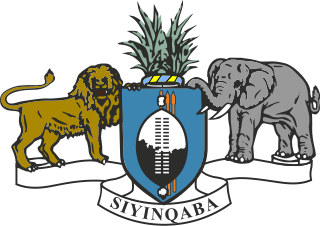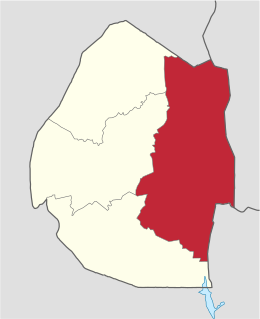
Eswatini, officially the Kingdom of Eswatini, sometimes written in English as eSwatini, and formerly and still commonly known in English as Swaziland, is a landlocked country in Southern Africa. It is bordered by Mozambique to its northeast and South Africa to its north, west, and south. At no more than 200 kilometres (120 mi) north to south and 130 kilometres (81 mi) east to west, Eswatini is one of the smallest countries in Africa; despite this, its climate and topography are diverse, ranging from a cool and mountainous highveld to a hot and dry lowveld.

Eswatini is an absolute monarchy with constitutional provisions and Swazi law and Custom. The head of state is the king or Ngwenyama, currently King Mswati III, who ascended to the throne in 1986 after the death of his father King Sobhuza II in 1982 and a period of regency. According to the constitution of Eswatini, the king and Ingwenyama is a symbol of unity and the eternity of the Swazi nation. By tradition, the king reigns along with his mother or a ritual substitute, the Ndlovukati. The former was viewed as the administrative head of state and the latter as a spiritual and national head of state, with real power counterbalancing that of the king, but during the long reign of Sobhuza II the role of the Ndlovukati became more symbolic. The king appoints the prime minister from the legislature and also appoints a minority of legislators to both chambers of Libandla (parliament), with help from an advisory council. The king is allowed by the constitution to appoint some members to parliament for special interests. These special interests are citizens who might have been left out by the electorate during the course of elections or did not enter as candidates. This is done to balance views in parliament. Special interests could be people of gender, race, disability, business community, civic society, scholars, chiefs and so on. The Senate consists of 30 members, of which some are appointed by the king on recommendation of the advisory council and others elected by the lower house. The House of Assembly has 65 seats, 55 of which are occupied by elected representatives from the 55 constituencies around the country, 10 appointed by the king on recommendation of the advisory council and the attorney general is the ex-officio member. Elections are held every five years.

Artifacts indicating human activity dating back to the early Stone Age have been found in the Kingdom of Eswatini. Prehistoric rock art paintings date from c. 25,000 B.C. and continuing up to the 19th century can be found in various places around the country. The earliest known inhabitants of the region were Khoisan hunter-gatherers. Later, the population became predominantly Nguni during and after the great Bantu migrations. People speaking languages ancestral to the current Sotho and Nguni languages began settling no later than the 11th century. The country now derives its name from a later king named Mswati II. Ngwane, named for Ngwane III, is an alternative name for Swaziland the surname of whose royal house remains Nkhosi Dlamini. Nkhosi literally means "king". Mswati II was the greatest of the fighting kings of Eswatini, and he greatly extended the area of the country to twice its current size. The people of Eswatini largely belong to a number of clans that can be categorized as Emakhandzambili, Bemdzabu and Emafikamuva. This depends on when and how they settled in Eswatini. The autonomy of the Emaswati was influenced by British and Dutch rule of Southern Africa in the 19th and early 20th centuries. In 1881 the British government signed a convention recognising Swazi independence. However, in 1894, a convention placed Swaziland under the South African Republic as a protectorate. In 1903, following the British victory in the Anglo-Boer war, Swaziland became a British protectorate. Much of its early administration being carried out from South Africa until 1906 when the Transvaal colony was granted self-government. Eswatini regained independence on 6 September 1968 and became the Kingdom of Swaziland. This was after brief period as a Protected State. Sobhuza II, the king at independence, became Ingwenyama in 1899 following the death of his father Ngwane V. His official coronation was in December 1921 after the regency of Labotsibeni after which he led an unsuccessful deputation to the Privy council in London in 1922 regarding the issue of land. The constitution for independent Swaziland was promulgated by Britain in November 1963 under the terms of which legislative and executive councils were established. This development was opposed by the Swazi National Council (Liqoqo). Despite such opposition, elections took place and the first Legislative Council of Swaziland was constituted on 9 September 1964. Changes to the original constitution proposed by the Legislative Council were accepted by Britain and a new constitution providing for a House of Assembly and Senate was drawn up. Elections under this constitution were held in 1967. Following the elections of 1973, the constitution of Swaziland was suspended by King Sobhuza II who thereafter ruled the country by decree until his death in 1982. At this point Sobhuza II had ruled Eswatini for 83 years, making him the longest ruling monarch in history. A regency followed his death, with Queen Regent Dzeliwe Shongwe being head of state until 1984 when she was removed by Liqoqo and replaced by Queen Mother Ntombi Twala. Mswati III, the son of Ntombi, was crowned king on 25 April 1986 as King and Ingwenyama of Eswatini. In 2018, during the 50th independence day celebration, the king announced the official renaming of the country from the Anglicized Swaziland to its Siswati form Eswatini. Following this, many governmental and non-governmental bodies, corporations and international organizations changed all mention of Swaziland to Eswatini.

Mswati III is the king of Eswatini and head of the Swazi Royal Family. He was born in Manzini in the Protectorate of Swaziland to King Sobhuza II and one of his younger wives, Ntfombi Tfwala. He was crowned as Mswati III, Ingwenyama and King of Swaziland, on 25 April 1986 at the age of 18, thus becoming the youngest ruling monarch in the world at that time. Together with his mother, Ntfombi Tfwala, now Queen Mother (Ndlovukati), he rules the country as an absolute monarch. Mswati III is known for his practice of polygyny and currently has 15 wives. His policies and lavish lifestyle have led to local protests and international criticism. Mswati III was also secretly funded and supported by the government of apartheid-era South Africa.

Hhohho is a region of Eswatini, located in the north western part of the country. Hhohho was named after the capital of King Mswati II, who expanded the Swazi territory to the north and west, taking in the districts of Barberton, Nelspruit, Carolina and Piet Retief. These areas were later acquired by what was the Province of Transvaal and today they form part of the Mpumalanga Province of South Africa. It has an area of 3,625.17 km², a population of 320,651 (2017), and is divided into 14 tinkhundla. The administrative center is the national capital of Mbabane. It borders Lubombo Region on the southeast and Manzini Region in the southwest.

Manzini is a region of Eswatini, located in the center-west of the country. It has an area of 4,093.59 km² and a population of 355,945 (2017). Its administrative center is Manzini. It borders all three other regions: Hhohho in the north, Lubombo in the east, and Shiselweni in the south. It is bordered by the Mpumalanga province in South Africa to the west.

Shiselweni is a region of Eswatini, located in the south of the country. It has an area of 3,786.71 km² and a population of 204,111 (2017). Its administrative center is Nhlangano. It borders Lubombo in the northeast and Manzini Region in the northwest.

The Parliament of Eswatini is bicameral, consisting of a lower chamber and an upper one. Some of the members of both chambers are elected, while the rest are appointed by the King of Eswatini. Election is by secret ballot in a first-past-the-post system of voting. Members of both chambers serve for five-year terms. All candidates run on a non-partisan basis, as political parties are banned.

The House of Assembly of Eswatini is the lower chamber of the country's bicameral Parliament. The Assembly may debate and pass bills.

The Senate of Eswatini is the upper chamber of the country's bicameral Parliament. The Senate may debate or pass a bill, with the exception of a "money bill", which must first be introduced in the lower chamber, the House of Assembly.

In Eswatini, an inkhundla is an administrative subdivision smaller than a district but larger than an umphakatsi. There are 55 tinkhundla in Eswatini: 14 in Hhohho District, 11 in Lubombo District, 16 in Manzini District, and 14 in Shishelweni District. According to the constitution of Eswatini, the government for Eswatini is a democratic, participatory, tinkhundla-based system that emphasizes devolution of state power from central government to tinkhundla areas and individual merit as a basis for election or appointment to public office. The system is non-partisan since the constitution does not recognize political parties, although section 25 of the constitution allows for open freedom of assembly and association. Each inkhundla elects one representative to the House of Assembly of Eswatini, the lower chamber of the bicameral parliament (Libandla). The same trend is applied in local government elections. This governing system was designed by King Sobhuza II with the assistance of political scholars and lawyers. It came to effect in 1978 and was adjusted in the early 1990s.
The Eswatini national rugby union team represent Eswatini in the sport of rugby union. They are ranked as a tier-three nation by the International Rugby Board (IRB). Eswatini have thus far not qualified for a Rugby World Cup, but have competed in qualifying tournaments.

Eswatini–United States relations are bilateral relations between Eswatini and the United States.
ISO 3166-2:SZ is the entry for Eswatini in ISO 3166-2, part of the ISO 3166 standard published by the International Organization for Standardization (ISO), which defines codes for the names of the principal subdivisions of all countries coded in ISO 3166-1.
Education in Eswatini includes pre-school, primary, secondary and high schools, for general education and training (GET), and universities and colleges at tertiary level.

General elections were held in Swaziland in September and October 1993. The elections was held using the Tinkhundla system, in which voters elected members to an electoral college, who then selected 55 non-party candidates for the Parliament, whilst the King appointed a further ten.

Lubombo is a region of Eswatini, located in the east of the country. It has an area of 5,849.11 km² and a population of 212,531 (2017). Its administrative center is Siteki. It borders all three other regions: Hhohho to the north, Manzini to the west, and Shiselweni to the south. It is divided into 11 tinkhundla.
The Miss Eswatini is a national beauty pageant in Eswatini.
Eswatini remained a British protectorate throughout World War II. As such, it fought alongside the Allies against the Axis. While no large scale battles or major military operations took place in or around Eswatini, the colony did supply the Allies with troops during the war. World War II was also responsible for several important domestic developments in Eswatini.










